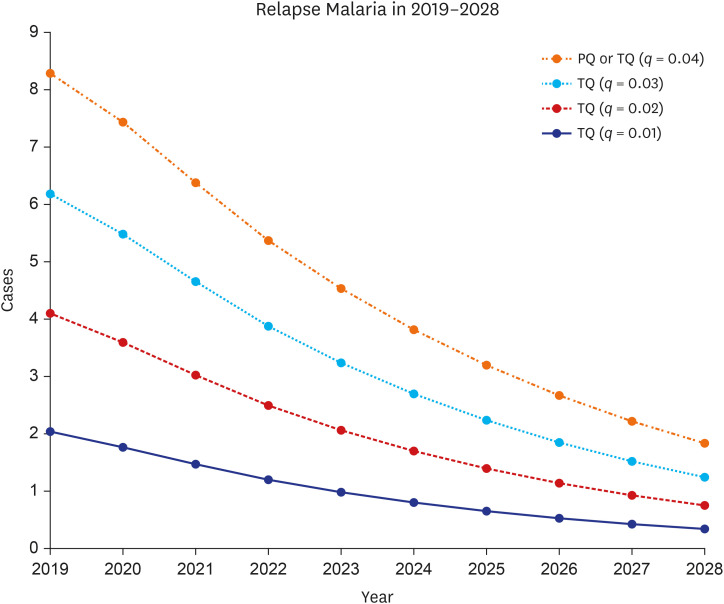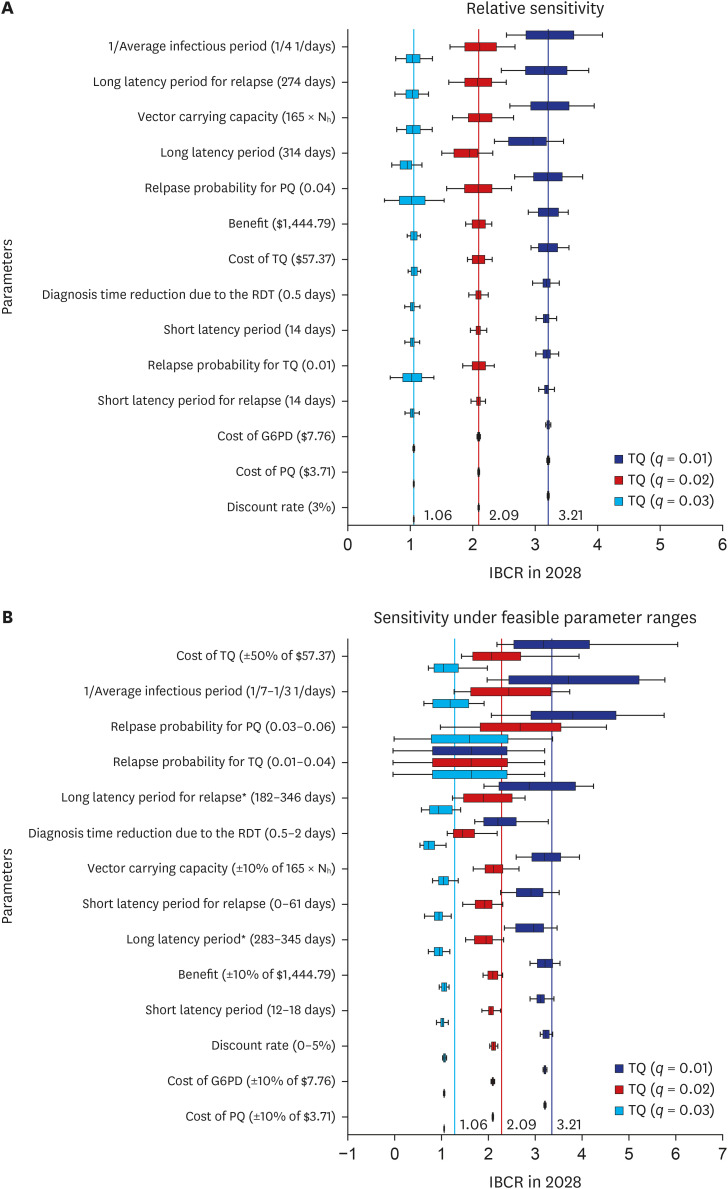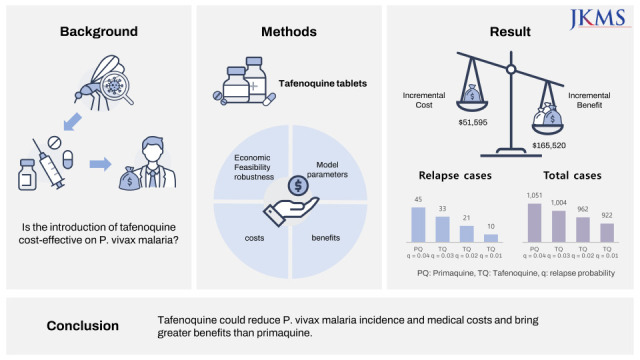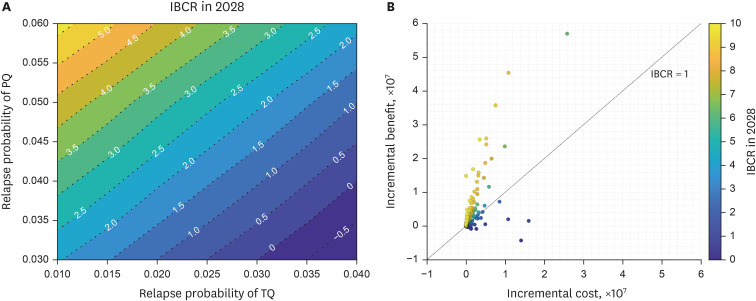1. World Health Organization. World Malaria Report 2020: 20 Years of Global Progress and Challenges. Geneva, Switzerland: World Health Organization;2020.
2. Battle KE, Lucas TC, Nguyen M, Howes RE, Nandi AK, Twohig KA, et al. Mapping the global endemicity and clinical burden of Plasmodium vivax, 2000-17: a spatial and temporal modelling study. Lancet. 2019; 394(10195):332–343. PMID:
31229233.

3. Liu Q, Jing W, Kang L, Liu J, Liu M. Trends of the global, regional and national incidence of malaria in 204 countries from 1990 to 2019 and implications for malaria prevention. J Travel Med. 2021; 28(5):taab046. PMID:
33763689.

4. White NJ, Imwong M. Relapse. Adv Parasitol. 2012; 80:113–150. PMID:
23199487.

5. Battle KE, Karhunen MS, Bhatt S, Gething PW, Howes RE, Golding N, et al. Geographical variation in Plasmodium vivax relapse. Malar J. 2014; 13(1):144. PMID:
24731298.

6. World Health Organization. Guidelines for the Treatment of Malaria. Geneva, Switzerland: World Health Organization;2015.
7. Galappaththy GN, Tharyan P, Kirubakaran R. Primaquine for preventing relapse in people with Plasmodium vivax malaria treated with chloroquine. Cochrane Database Syst Rev. 2013; 2013(10):CD004389.
8. John GK, Douglas NM, von Seidlein L, Nosten F, Baird JK, White NJ, et al. Primaquine radical cure of Plasmodium vivax: a critical review of the literature. Malar J. 2012; 11(1):280. PMID:
22900786.

9. Pereira EA, Ishikawa EA, Fontes CJ. Adherence to
Plasmodium vivax malaria treatment in the Brazilian Amazon Region. Malar J. 2011; 10(1):355. PMID:
22165853.
10. Douglas NM, Poespoprodjo JR, Patriani D, Malloy MJ, Kenangalem E, Sugiarto P, et al. Unsupervised primaquine for the treatment of Plasmodium vivax malaria relapses in southern Papua: a hospital-based cohort study. PLoS Med. 2017; 14(8):e1002379. PMID:
28850568.

11. Taylor WR, Thriemer K, von Seidlein L, Yuentrakul P, Assawariyathipat T, Assefa A, et al. Short-course primaquine for the radical cure of
Plasmodium vivax malaria: a multicentre, randomised, placebo-controlled non-inferiority trial. Lancet. 2019; 394(10202):929–938. PMID:
31327563.
12. Milligan R, Daher A, Villanueva G, Bergman H, Graves PM. Primaquine alternative dosing schedules for preventing malaria relapse in people with
Plasmodium vivax
. Cochrane Database Syst Rev. 2020; 8:CD012656. PMID:
32816320.
13. Lacerda MV, Llanos-Cuentas A, Krudsood S, Lon C, Saunders DL, Mohammed R, et al. Single-dose tafenoquine to prevent relapse of
Plasmodium vivax malaria. N Engl J Med. 2019; 380(3):215–228. PMID:
30650322.

14. Llanos-Cuentas A, Lacerda MV, Rueangweerayut R, Krudsood S, Gupta SK, Kochar SK, et al. Tafenoquine plus chloroquine for the treatment and relapse prevention of
Plasmodium vivax malaria (DETECTIVE): a multicentre, double-blind, randomised, phase 2b dose-selection study. Lancet. 2014; 383(9922):1049–1058. PMID:
24360369.

15. Llanos-Cuentas A, Lacerda MV, Hien TT, Vélez ID, Namaik-Larp C, Chu CS, et al. Tafenoquine versus primaquine to prevent relapse of
Plasmodium vivax malaria. N Engl J Med. 2019; 380(3):229–241. PMID:
30650326.

16. Rajapakse S, Rodrigo C, Fernando SD. Tafenoquine for preventing relapse in people with Plasmodium vivax malaria. Cochrane Database Syst Rev. 2015; 2015(4):CD010458.
17. Islam N, Wright S, Lau CL, Doi SA, Mills DJ, Clark J, et al. Efficacy of a 3-day pretravel schedule of tafenoquine for malaria chemoprophylaxis: a network meta-analysis. J Travel Med. 2021; 28(5):taab057. PMID:
33834208.

18. Baird JK. Single loading-dose tafenoquine for malaria chemoprophylaxis during brief travel? J Travel Med. 2021; 28(5):taab081. PMID:
34050367.

19. Freedman DO. Tafenoquine: integrating a new drug for malaria prophylaxis into travel medicine practice. J Travel Med. 2019; 26(4):tay140. PMID:
30496585.

20. Ahmad SS, Rahi M, Sharma A. Relapses of Plasmodium vivax malaria threaten disease elimination: time to deploy tafenoquine in India? BMJ Glob Health. 2021; 6(2):e004558.
21. Chu CS, Freedman DO. Tafenoquine and G6PD: a primer for clinicians. J Travel Med. 2019; 26(4):taz023. PMID:
30941413.

22. Kim S, Byun JH, Park A, Jung IH. A mathematical model for assessing the effectiveness of controlling relapse in
Plasmodium vivax malaria endemic in the Republic of Korea. PLoS One. 2020; 15(1):e0227919. PMID:
31978085.
23. Nekkab N, Lana R, Lacerda M, Obadia T, Siqueira A, Monteiro W, et al. Estimated impact of tafenoquine for
Plasmodium vivax control and elimination in Brazil: a modelling study. PLoS Med. 2021; 18(4):e1003535. PMID:
33891582.
24. Kostić M, Milosavljević MN, Stefanović S, Ranković G, Janković SM. Cost-utility of tafenoquine vs. primaquine for the radical cure (prevention of relapse) of
Plasmodium vivax malaria. J Chemother. 2020; 32(1):21–29. PMID:
31524099.

25. Devine A, Howes RE, Price DJ, Moore KA, Ley B, Simpson JA, et al. Cost-effectiveness analysis of sex-stratified
Plasmodium vivax treatment strategies using available G6PD diagnostics to accelerate access to radical cure. Am J Trop Med Hyg. 2020; 103(1):394–403. PMID:
32372747.

26. Kim JH, Suh J, Lee WJ, Choi H, Kim JD, Kim C, et al. Modelling the impact of rapid diagnostic tests on Plasmodium vivax malaria in South Korea: a cost-benefit analysis. BMJ Glob Health. 2021; 6(2):e004292.
27. Kwak YG, Lee HK, Kim M, Um TH, Cho CR. Clinical characteristics of vivax malaria and analysis of recurred patients. Infect Chemother. 2013; 45(1):69–75. PMID:
24265952.

28. Korea Centers for Disease Control and Prevention. Malaria Management Guidelines 2019. Cheongju, Korea: Korea Centers for Disease Control and Prevention;2019.
29. World Health Organization. WHO Guideline for Malaria, 13 July 2021. Geneva, Switzerland: World Health Organization;2021.
30. Kim L, Kim JA, Kim S. A guide for the utilization of health insurance review and assessment service national patient samples. Epidemiol Health. 2014; 36:e2014008. PMID:
25078381.

31. Lee J, Lee JS, Park SH, Shin SA, Kim K. Cohort profile: the national health insurance service–national sample cohort (NHIS-NSC), South Korea. Int J Epidemiol. 2017; 46(2):e15. PMID:
26822938.

32. Choi MJ, Song JY, Noh JY, Yoon JG, Lee SN, Heo JY, et al. Disease burden of hospitalized community-acquired pneumonia in South Korea: analysis based on age and underlying medical conditions. Medicine (Baltimore). 2017; 96(44):e8429. PMID:
29095281.
33. Korea Centers for Disease Control and Prevention. Malaria Management Guidelines 2018. Cheongju, Korea: Korea Centers for Disease Control and Prevention;2018.
34. Goo YK, Ji SY, Shin HI, Moon JH, Cho SH, Lee WJ, et al. First evaluation of glucose-6-phosphate dehydrogenase (G6PD) deficiency in vivax malaria endemic regions in the Republic of Korea. PLoS One. 2014; 9(5):e97390. PMID:
24853873.

35. Khantikul N, Butraporn P, Kim HS, Leemingsawat S, Tempongko MA, Suwonkerd W. Adherence to antimalarial drug therapy among vivax malaria patients in northern Thailand. J Health Popul Nutr. 2009; 27(1):4–13. PMID:
19248643.

36. Pybus BS, Sousa JC, Jin X, Ferguson JA, Christian RE, Barnhart R, et al. CYP450 phenotyping and accurate mass identification of metabolites of the 8-aminoquinoline, anti-malarial drug primaquine. Malar J. 2012; 11(1):259. PMID:
22856549.

37. Pybus BS, Marcsisin SR, Jin X, Deye G, Sousa JC, Li Q, et al. The metabolism of primaquine to its active metabolite is dependent on CYP 2D6. Malar J. 2013; 12(1):212. PMID:
23782898.

38. Bennett JW, Pybus BS, Yadava A, Tosh D, Sousa JC, McCarthy WF, et al. Primaquine failure and cytochrome P-450 2D6 in
Plasmodium vivax malaria. N Engl J Med. 2013; 369(14):1381–1382. PMID:
24088113.

39. Choi S, Choi H, Park SY, Kwak YG, Song JE, Shin SY, et al. Four times of relapse of
Plasmodium vivax malaria despite primaquine treatment in a patient with impaired cytochrome P450 2D6 function. Korean J Parasitol. 2022; 60(1):39–43. PMID:
35247953.

40. St Jean PL, Xue Z, Carter N, Koh GC, Duparc S, Taylor M, et al. Tafenoquine treatment of
Plasmodium vivax malaria: suggestive evidence that CYP2D6 reduced metabolism is not associated with relapse in the phase 2b DETECTIVE trial. Malar J. 2016; 15(1):97. PMID:
26888075.
41. Chen V, Daily JP. Tafenoquine: the new kid on the block. Curr Opin Infect Dis. 2019; 32(5):407–412. PMID:
31305490.
42. Lewis J, Gregorian T, Portillo I, Goad J. Drug interactions with antimalarial medications in older travelers: a clinical guide. J Travel Med. 2020; 27(1):taz089. PMID:
31776555.

43. Nkhoma ET, Poole C, Vannappagari V, Hall SA, Beutler E. The global prevalence of glucose-6-phosphate dehydrogenase deficiency: a systematic review and meta-analysis. Blood Cells Mol Dis. 2009; 42(3):267–278. PMID:
19233695.

44. Howes RE, Piel FB, Patil AP, Nyangiri OA, Gething PW, Dewi M, et al. G6PD deficiency prevalence and estimates of affected populations in malaria endemic countries: a geostatistical model-based map. PLoS Med. 2012; 9(11):e1001339. PMID:
23152723.

45. Lee W, Lee SE, Lee MJ, Noh KT. Investigation of glucose-6-phosphate dehydrogenase (G6PD) deficiency prevalence in a
Plasmodium vivax-endemic area in the Republic of Korea (ROK). Malar J. 2020; 19(1):317. PMID:
32873296.








 PDF
PDF Citation
Citation Print
Print





 XML Download
XML Download